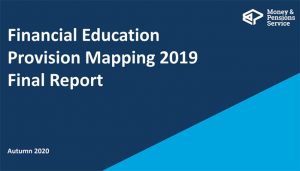Financial education provision mapping 2019 – final report summary
To help support the UK Strategy for Financial Wellbeing’s goal of two million more children and young people receiving a meaningful financial education by 2030, the Money and Pensions Service (MaPS) and UK Finance came together to map the current state of financial education delivery and reach across the UK.
With the support of HM Treasury, the provision mapping work aims to build an up-to-date picture of projects, interventions, and activities delivering financial education to under 18 year olds in the UK. This will allow MaPS and the wider sector to scale the provision of meaningful financial education and identify and address gaps in provision to target financial education where it is most needed.
Key findings
The mapping work identified 94 financial education interventions for children and young people, with a reported annual reach of around 3.1m children and young people and annual spend of around £7.3m.
Key highlights include:
- The most common method of delivering financial education was direct delivery to children and young people.
- Financial education was most commonly aimed at older children.
- Under half of the mapped interventions included a focus on specific needs.
- Financial services continued to be the biggest funder, partly or wholly funding interventions that represent 59% of total spend and 72% of total reach.
- Voluntary and community organisations were the largest sector in terms of the number of interventions: they delivered 55 interventions, either alone or in partnership, with a total reach of nearly 2.1m.
- Based on reported delivery in 2018/19 –2019/20, it appears that a greater proportion of interventions were accessed in areas of greater deprivation.
This provision mapping exercise also identified key gaps in provision, including:
- geographical gaps
- interventions targeted at children with currently unmet specific needs, such as children with behavioural difficulties and low levels of numeracy/literacy, care experienced children, and children growing up in poverty
- investment in and use of evidence based approaches, such as ‘train the trainer’ approaches
- testing and research into other methods to deliver financial education, such as financial products, online interventions, and digital tools
- delivery of financial education programmes via youth and community groups and volunteer programmes
- working with parents, and
- interventions for younger children.
The findings identified in this analysis will continue to be one of several data and information sources that are reviewed and utilised by MaPS to inform a number of strategies, including our children and young people commissioning strategy, our corporate strategy, and the work being undertaken as part of the UK Strategy for Financial Wellbeing. We intend to put out a new call for information every three years, ahead of production of new commissioning plans.

